Synths Timeline |
| Tubular Bells (1973) |
| Farfisa Professional Organ |
Return To Ommadawn used a Farfisa sotware emulation.

 |
A Farfisa organ was hired from Maurice Placquet, but it broke down. It's not clear whether the only Farfisa on the album is the broken hired organ or whether another was borrowed (for example, the Farfisa Mike had borrowed for the demos).
|
| Hammond Organ |
As this doesn't appear to have been hired from Maurice Placquet (it at least doesn't appear on the 1972 hire receipt), it would seem that this was either owned by The Manor or belonged to one of the bands who were recording there at the time. The model isn't known, but it was quite possibly a B3, certainly with a Leslie speaker. It's used towards the end of Part Two. |
|
| Lowrey Organ |
|
|
| Hergest Ridge (1974) |
| Gemini Organ |
|
|
| Farfisa Professional Organ |
Return To Ommadawn used a Farfisa sotware emulation.

 |
|
| Lowrey Organ |
|
|
| Ommadawn (1975) |
| ARP 2600 |
Semi-modular analogue monophonic synthesiser. |
|
| Solina string ensemble |
String synthesiser produced by the Dutch organ company Eminent and later rebadged by ARP. It owed much of its sound to its ensemble effect, created by running the sound through three LFO-modulated delay lines. |
|
| Farfisa Professional Organ |
Return To Ommadawn used a Farfisa sotware emulation.

 |
|
| Incantations (1978) |
| ARP 2600 |
Semi-modular analogue monophonic synthesiser. |
|
| Solina string ensemble |
String synthesiser produced by the Dutch organ company Eminent and later rebadged by ARP. It owed much of its sound to its ensemble effect, created by running the sound through three LFO-modulated delay lines. |
|
| EMS Universal Sequencer |
Related to the sequencer from EMS's Synthi KS (available both on its own and as part of the Synthi AKS suitcase synthesiser/sequencer, as used by Pink Floyd and Jean Michel Jarre, amongst others). The Universal Sequencer had control voltage and gate outputs for controlling analogue synthesisers. Mike primarily used it together with his ARP 2600. According to EMS, very few of them were made. |
[?] |
| Farfisa Professional Organ |
Return To Ommadawn used a Farfisa sotware emulation.

 |
|
| Roland SH-2000 |
Monophonic analogue synthesiser. Mike often used the clarinet preset, recording it at half speed to create the recorder-like whistling sound which was a common feature of his albums and singles between 1978 and 1980. |
|
| Platinum (1979) |
| Solina string ensemble |
String synthesiser produced by the Dutch organ company Eminent and later rebadged by ARP. It owed much of its sound to its ensemble effect, created by running the sound through three LFO-modulated delay lines. |
|
| EMS Universal Sequencer |
Related to the sequencer from EMS's Synthi KS (available both on its own and as part of the Synthi AKS suitcase synthesiser/sequencer, as used by Pink Floyd and Jean Michel Jarre, amongst others). The Universal Sequencer had control voltage and gate outputs for controlling analogue synthesisers. Mike primarily used it together with his ARP 2600. According to EMS, very few of them were made. |
[?] |
| Moog Polymoog |
Polyphonic analogue synthesiser. |
|
| Roland SH-2000 |
Monophonic analogue synthesiser. Mike often used the clarinet preset, recording it at half speed to create the recorder-like whistling sound which was a common feature of his albums and singles between 1978 and 1980. |
|
| Sequential Circuits Prophet V |

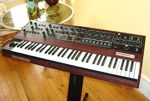 |
|
| QE2 (1980) |
| Solina string ensemble |
String synthesiser produced by the Dutch organ company Eminent and later rebadged by ARP. It owed much of its sound to its ensemble effect, created by running the sound through three LFO-modulated delay lines. |
|
| Barth Musicoder |
Analogue vocoder built in the early 1980s by the R. Barth company in Hamburg, Germany. |
In the 1981 Montreux concert video, Mike can be seen playing the vocoder parts on his Polymoog, with the MusiCoder in the rack case next to it. The closeness of the sound to that on the album suggests this is likely the same combination he used in the studio.
|
| EMS Universal Sequencer |
Related to the sequencer from EMS's Synthi KS (available both on its own and as part of the Synthi AKS suitcase synthesiser/sequencer, as used by Pink Floyd and Jean Michel Jarre, amongst others). The Universal Sequencer had control voltage and gate outputs for controlling analogue synthesisers. Mike primarily used it together with his ARP 2600. According to EMS, very few of them were made. |
[?] |
| Linn LM-1 |
Electronic drum machine, using samples of acoustic drums |
[?] Can be seen in the 1981 Montreux concert video, but was released in 1980, so likely bought after the album was recorded.
|
| Moog Polymoog |
Polyphonic analogue synthesiser. |
|
| Moog Taurus |
Bass pedals |
|
| Pollard Syndrum |
Possibly a syndrum quad. |
Mentioned in the album credits.
|
| Roland CompuRhythm CR-78 |
Analogue drum machine |
|
| Sequential Circuits Prophet V |

 |
|
| Simmons Claptrap |
Handclap synthesiser. |
Mentioned in the album credits.
|
| Yamaha CS-80 |
Polyphonic analogue synthesiser, used on QE2 but probably owned by David Hentschel. |
|
| Five Miles Out (1982) |
| Solina string ensemble |
String synthesiser produced by the Dutch organ company Eminent and later rebadged by ARP. It owed much of its sound to its ensemble effect, created by running the sound through three LFO-modulated delay lines. |
|
| Barth Musicoder |
Analogue vocoder built in the early 1980s by the R. Barth company in Hamburg, Germany. |
Seen in multiple pictures both in Mike's studio (it's on top of the Fairlight keyboard in the photo inside the LP gatefold) and on the Five Miles Out tour.
|
| EMS Universal Sequencer |
Related to the sequencer from EMS's Synthi KS (available both on its own and as part of the Synthi AKS suitcase synthesiser/sequencer, as used by Pink Floyd and Jean Michel Jarre, amongst others). The Universal Sequencer had control voltage and gate outputs for controlling analogue synthesisers. Mike primarily used it together with his ARP 2600. According to EMS, very few of them were made. |
Shown in the photo of Mike's studio on inside of the gatefold of the LP
|
| Linn LM-1 |
Electronic drum machine, using samples of acoustic drums |
'Linn Machine' is listed on the track sheet, and the LM-1 can be seen in the gatefold photo of his studio.
|
| Sequential Circuits Prophet V |

 |
|
| Crises (1983) |
| Solina string ensemble |
String synthesiser produced by the Dutch organ company Eminent and later rebadged by ARP. It owed much of its sound to its ensemble effect, created by running the sound through three LFO-modulated delay lines. |
|
| Fairlight CMI Series II |
Mike had two of these - the second was for live work. |
|
| Farfisa Professional Organ |
Return To Ommadawn used a Farfisa sotware emulation.

 |
|
| Oberheim DMX |
Digital drum machine.

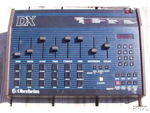 |
|
| Oberheim DSX |
Sequencer. Used as an interface between Mike's analogue synths and the Fairlight CMI. |
|
| Oberheim OB-Xa |
Sold together with DSX sequencer and 'Tubular Bells' flightcase to "Malcolm" for £540 in Spring 2000 at vemia.co.uk. OB-Xa later resold on ebay, March 2007. |
|
| Roland G-808 |
Guitar controller for Roland guitar synthesis system.

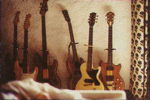 |
|
| 1983 Roland G-88 Bass Guitar Controller, Serial # A814722 |
Bass guitar designed for controlling the GR-33B bass synthesiser. It can also be used as a conventional bass, which Mike seems to have done.
Sold on Guitar Auctions with a Roland GR-33B bass guitar synthesizer pedal unit, Serial # 050634 (missing multi-pin cable).
Purchased by the vendor in October 1994 haveing been offered the bass by Jeremy Parker, Mike's then personal assistant. The vendor was offered the guitar as he was a known fan of Mike Oldfield.
The instrument can be seen in the videos for 'Shadow On The Wall', 'Pictures In The Dark' and 'Islands'.
          
 |
Mike appears with it in the Shadow on the Wall video, so it's quite likely he used it on the album.
|
| Roland GR-100 |
Guitar synthesis module controlled by Gibson SG with the Roland STK-1 GK kit. |
|
| Roland VP-330 |
Analogue vocoder keyboard, often also used for its string sound. |
Used for its string sound - listed as 'Roland Strings'
|
| Sequential Circuits Prophet V |

 |
|
| Simmons Drums |
|
|
| Discovery (1984) |
| Fairlight CMI Series II |
Mike had two of these - the second was for live work. |
|
| Oberheim DMX |
Digital drum machine.

 |
Can be seen on top of the OBXa in Mike's 'synth corner' shown on the sleeve of some LPs of the album.
|
| Oberheim DSX |
Sequencer. Used as an interface between Mike's analogue synths and the Fairlight CMI. |
Can just be made out next to the DMX in Mike's 'synth corner' shown on the sleeve of some LPs of the album.
|
| Oberheim OB-Xa |
Sold together with DSX sequencer and 'Tubular Bells' flightcase to "Malcolm" for £540 in Spring 2000 at vemia.co.uk. OB-Xa later resold on ebay, March 2007. |
Can be seen perched on top of the Fairlight keyboard in Mike's 'synth corner' shown on the sleeve of some LPs of the album.
|
| Roland G-808 |
Guitar controller for Roland guitar synthesis system.

 |
|
| 1983 Roland G-88 Bass Guitar Controller, Serial # A814722 |
Bass guitar designed for controlling the GR-33B bass synthesiser. It can also be used as a conventional bass, which Mike seems to have done.
Sold on Guitar Auctions with a Roland GR-33B bass guitar synthesizer pedal unit, Serial # 050634 (missing multi-pin cable).
Purchased by the vendor in October 1994 haveing been offered the bass by Jeremy Parker, Mike's then personal assistant. The vendor was offered the guitar as he was a known fan of Mike Oldfield.
The instrument can be seen in the videos for 'Shadow On The Wall', 'Pictures In The Dark' and 'Islands'.
          
 |
|
| Roland GR-100 |
Guitar synthesis module controlled by Gibson SG with the Roland STK-1 GK kit. |
|
| Roland GR-33B |
Bass guitar synthesizer module controlled by a Roland G 88 bass guitar fitted with a synth pickup. |
|
| Roland VP-330 |
Analogue vocoder keyboard, often also used for its string sound. |
Can clearly be seen in Mike's 'synth corner' shown on the sleeve of some LPs of the album.
|
| Sequential Circuits Prophet V |

 |
|
| The Killing Fields (1984) |
| Fairlight CMI Series II |
Mike had two of these - the second was for live work. |
|
| Oberheim DMX |
Digital drum machine.

 |
|
| Oberheim OB-Xa |
Sold together with DSX sequencer and 'Tubular Bells' flightcase to "Malcolm" for £540 in Spring 2000 at vemia.co.uk. OB-Xa later resold on ebay, March 2007. |
|
| Islands (1987) |
| Fairlight CMI Series III |
A further improvement of the CMI system, incorporating 16 bit sampling.

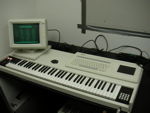 |
|
| Kurzweil K250 |
|
|
| Roland D-110 |
Linear Algorhythmic synthesis module. |
|
| Roland D-50 |
Linear Algorhythmic synthesiser keyboard. |
|
| 1983 Roland G-88 Bass Guitar Controller, Serial # A814722 |
Bass guitar designed for controlling the GR-33B bass synthesiser. It can also be used as a conventional bass, which Mike seems to have done.
Sold on Guitar Auctions with a Roland GR-33B bass guitar synthesizer pedal unit, Serial # 050634 (missing multi-pin cable).
Purchased by the vendor in October 1994 haveing been offered the bass by Jeremy Parker, Mike's then personal assistant. The vendor was offered the guitar as he was a known fan of Mike Oldfield.
The instrument can be seen in the videos for 'Shadow On The Wall', 'Pictures In The Dark' and 'Islands'.
          
 |
|
| Roland GR-33B |
Bass guitar synthesizer module controlled by a Roland G 88 bass guitar fitted with a synth pickup. |
|
| Roland MT-32 |
Table top Linear Algorhythmic Synthesis module. Low cost descendent of the D-50. Mike had two, for composing with while he was on holiday. |
|
| Yamaha DX-7 |
6 operator polyphonic digital FM synthesiser keyboard. Later given to a school for the disabled in exchange for a Farfisa Professional for Tubular Bells II. |
[?] Seems to feature quite heavily in The Wind Chimes.
|
| Earth Moving (1989) |
| Atari STacy portable computer |
Used as part of Mike's late 80s portable sequencing setup, together with the walkman with powered speakers and two Roland MT32 sound modules. |
|
| C-Lab Notator |
Sequencing software for the Atari ST |
|
| Fairlight CMI Series III |
A further improvement of the CMI system, incorporating 16 bit sampling.

 |
|
| Korg M1 |
The biggest selling digital keyboard of all time, the Korg M1 was used by many artists after its release in 1988. |
|
| Roland D-110 |
Linear Algorhythmic synthesis module. |
|
| Roland D-50 |
Linear Algorhythmic synthesiser keyboard. |
|
| Roland MT-32 |
Table top Linear Algorhythmic Synthesis module. Low cost descendent of the D-50. Mike had two, for composing with while he was on holiday. |
|
| Yamaha DX-100 |
Small synthesiser, used as a controller keyboard for Mike's 1980s portable sequencing setup. |
In the 1989 Keyboards interview, Mike mentions using a small portable Roland keyboard while writing the album in Greece. It's listed in the article as a Roland DX 800, which never existed. It was probably this keyboard which was meant.
|
| Amarok (1990) |
| Farfisa Professional Organ |
Return To Ommadawn used a Farfisa sotware emulation.

 |
Having sold his original Farfisa organ, Mike obtained another in preparation for Tubular Bells II. He found it in a school for the disabled, and swapped it for his Yamaha DX7.
|
| 1970 Hammond L.122 Organ |
Return To Ommadawn used an Hammond software simulation. |
|
| Lowrey Organ |
|
|
| Roland D-50 |
Linear Algorhythmic synthesiser keyboard. |
Mike told H & SR magazine that he'd used "a string sound and a bell-like sound" from the D50.
|
| Roland VP-330 |
Analogue vocoder keyboard, often also used for its string sound. |
Mike told H & SR Magazine that he'd used this on the album for "some robot voices".
|
| Vox Continental Organ |
Return To Ommadawn used a Vox software emulation. |
|
| Heaven's Open (1991) |
| Akai S-1100 |
Mike owned both an 8MB and a 32MB version. |
|
| Atari STacy portable computer |
Used as part of Mike's late 80s portable sequencing setup, together with the walkman with powered speakers and two Roland MT32 sound modules. |
|
| C-Lab Notator |
Sequencing software for the Atari ST |
|
| E-Mu Proteus |
Digital sample playback sound module. |
|
| Fairlight CMI Series III |
A further improvement of the CMI system, incorporating 16 bit sampling.

 |
|
| 1970 Hammond L.122 Organ |
Return To Ommadawn used an Hammond software simulation. |
[?] As it's not listed in the sleeve notes, it may equally have been Mickey Simmonds's own Hammond organ used on the album.
|
| Korg M1 |
The biggest selling digital keyboard of all time, the Korg M1 was used by many artists after its release in 1988. |
|
| Roland D-50 |
Linear Algorhythmic synthesiser keyboard. |
|
| Roland D-550 |
Linear Algorhythmic Synthesis module. |
|
| Steinberg Topaz |
Hard disk recording system |
|
| Tubular Bells II (1992) |
| Akai S-1100 |
Mike owned both an 8MB and a 32MB version. |
|
| Atari STacy portable computer |
Used as part of Mike's late 80s portable sequencing setup, together with the walkman with powered speakers and two Roland MT32 sound modules. |
|
| C-Lab Notator |
Sequencing software for the Atari ST |
|
| E-Mu Proteus |
Digital sample playback sound module. |
|
| Ensoniq SD-1 |
|
|
| Farfisa Professional Organ |
Return To Ommadawn used a Farfisa sotware emulation.

 |
|
| 1970 Hammond L.122 Organ |
Return To Ommadawn used an Hammond software simulation. |
|
| Korg M1 |
The biggest selling digital keyboard of all time, the Korg M1 was used by many artists after its release in 1988. |
|
| Lowrey Organ |
|
|
| New England Digital Synclavier |

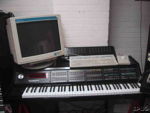 |
Mentioned in Keyboards, October 1992.
|
| Roland D-50 |
Linear Algorhythmic synthesiser keyboard. |
|
| Roland D-550 |
Linear Algorhythmic Synthesis module. |
|
| The Songs of Distant Earth (1994) |
| Akai S-1100 |
Mike owned both an 8MB and a 32MB version. |
Mike used two of these for playing back the many samples used on the album (as seen in the 1994 VH1 interview).
|
| Apple Macintosh Quadra 850 |
Running EMagic Logic Audio and Digidesign Pro Tools, connected to a 'two page' (usually used to describe a 21" CRT) monitor. It had four sets of Pro Tools hardware, to allow it to handle 16 tracks of audio. As mentioned in Sound on Sound, February 1995. |
|
| E-Mu Proteus |
Digital sample playback sound module. |
|
| Ensoniq SD-1 |
|
[?] |
| Korg M1 |
The biggest selling digital keyboard of all time, the Korg M1 was used by many artists after its release in 1988. |
Mike used this as the master keyboard for his sequencing setup.
|
| Roland D-50 |
Linear Algorhythmic synthesiser keyboard. |
[?] |
| Roland D-550 |
Linear Algorhythmic Synthesis module. |
[?] |
| Roland JD-990 |
Rackmountable module version of the JD-800, with slightly enhanced synthesis engine, but missing its numerous sliders! |
Mike used two of these on the album (as seen in the 1994 VH1 interview).
|
| Voyager (1996) |
| Korg Trinity |
|
[?] |
| Roland JD-990 |
Rackmountable module version of the JD-800, with slightly enhanced synthesis engine, but missing its numerous sliders! |
[?] |
| Roland JV-1080 |
Digital synth module. |
[?] |
| Roland XP-50 |
Digital synthesiser workstation. Bought by a fan in 2008 from Chandler Guitars. Can be seen in the Millenium Bells DVD, used for the beats for Art In Heaven among other things.
    
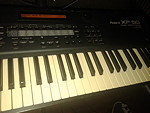 |
[?] |
| Tubular Bells III (1998) |
| Clavia Nord Lead |
|
|
| Korg Trinity |
|
|
| Roland JD-990 |
Rackmountable module version of the JD-800, with slightly enhanced synthesis engine, but missing its numerous sliders! |
[?] |
| Roland JV-1080 |
Digital synth module. |
|
| Roland XP-50 |
Digital synthesiser workstation. Bought by a fan in 2008 from Chandler Guitars. Can be seen in the Millenium Bells DVD, used for the beats for Art In Heaven among other things.
    
 |
[?] |
| Guitars (1999) |
| Roland GI-10 |
Guitar-MIDI interface, sold via eBay in December 2007.

 |
|
| The Millennium Bell (1999) |
| Clavia Nord Lead |
|
|
| Korg Trinity |
|
|
| Roland JD-990 |
Rackmountable module version of the JD-800, with slightly enhanced synthesis engine, but missing its numerous sliders! |
[?] |
| Roland JV-1080 |
Digital synth module. |
|
| Roland XP-50 |
Digital synthesiser workstation. Bought by a fan in 2008 from Chandler Guitars. Can be seen in the Millenium Bells DVD, used for the beats for Art In Heaven among other things.
    
 |
[?] |
| Tres Lunas (2002) |
| Akai S-6000 |
Digital rackmount sampler. |
[?] |
| Clavia Nord Lead |
|
|
| Native Instruments B4 |
Virtual Hammond B3 Organ |
|
| Roland GI-10 |
Guitar-MIDI interface, sold via eBay in December 2007.

 |
Used to help create the 'saxophone guitar' parts
|
| Roland JD-990 |
Rackmountable module version of the JD-800, with slightly enhanced synthesis engine, but missing its numerous sliders! |
[?] |
| Roland JV-2080 |
Digital synth module |
|
| Roland XP-50 |
Digital synthesiser workstation. Bought by a fan in 2008 from Chandler Guitars. Can be seen in the Millenium Bells DVD, used for the beats for Art In Heaven among other things.
    
 |
[?] |
| Tubular Bells 2003 (2003) |
| Akai S-6000 |
Digital rackmount sampler. |
Used for playing back Mike's sample library.
|
| Apple PowerMac G4 1GHz mirrored drive door |
With 1.25GB RAM, running OS 9.2 With Emagic Logic Audio Platinum 5.3.0 and Digidesign Pro Tools 5.3.1 |
|
| Apple Powerbook 5300 |
Used for recalls and general word processing |
|
| Apple PowerMac G4 466MHz |
With 1GB RAM, running OS 9.1, Logic Audio Platinum 4.8.1 and Pro Tools |
|
| Boss Dr Rhythm |
Digital drum machine. |
Used for drums.
|
| Clavia Nord Lead |
|
Used for bass and 'sequency synths'.
|
| Digidesign Pro Tools |
|
Mike used version 5.3.1
|
| Emagic ES1 |
|
Virtual bass
|
| Emagic EVP88 |
|
Virtual Wurlitzer electric piano
|
| Emagic EXS24 |
|
Used for strings, flutes and organs.
|
| Emagic Logic Platinum |
5.3.0 |
Mike started with version 4.8.1 and upgraded to 5.3.0 during the recording.
|
| Farfisa Professional Organ |
Return To Ommadawn used a Farfisa sotware emulation.

 |
|
| Focusrite EQ and Compression plugins |
|
|
| 1970 Hammond L.122 Organ |
Return To Ommadawn used an Hammond software simulation. |
|
| Korg Trinity |
|
|
| Line 6 Amp Farm |
TDM plugin for Pro Tools. |
|
| Lowrey Organ |
|
|
| Native Instruments Pro 53 |
Virtual Prophet V plugin, an update of the Pro52 |
Used for synth and organ sounds.
|
| Roland JD-990 |
Rackmountable module version of the JD-800, with slightly enhanced synthesis engine, but missing its numerous sliders! |
Used for pads.
|
| Roland JV-2080 |
Digital synth module |
Used for 'ethnic sounds' and bass.
|
| Roland XP-50 |
Digital synthesiser workstation. Bought by a fan in 2008 from Chandler Guitars. Can be seen in the Millenium Bells DVD, used for the beats for Art In Heaven among other things.
    
 |
Used for pianos and percussion.
|
| Light + Shade (2005) |
| Native Instruments Absynth 3, Altered States, Morphology, Reaktor, Sounds of Polynesia, Wired |
Virtual instruments |
|
| PC running Windows XP Pro |
Light + Shade era |
|
| Logic 7 |
Music editing software |
|
| Apple PowerMac G5 |
|
|
| Glaresoft iDrum |
Virtual instrument |
|
| FL Studio |
Music editing software |
|
| LinPlug Albino 2 |
Virtual instrument |
|
| reFX Vanguard |
3 oscillator, 32 voice analogue modelling synth plugin. |
|
| Roland XP-50 |
Digital synthesiser workstation. Bought by a fan in 2008 from Chandler Guitars. Can be seen in the Millenium Bells DVD, used for the beats for Art In Heaven among other things.
    
 |
This is a guess - he lists a Roland under 'keyboards' and this is a Roland keyboard which he owned at that time.
|
| Spectrasonics Atmosphere, Stylus RMX |
Virtual instruments |
|
| Steinberg Groove Agent, Hypersonic, Kantos, Slayer, XPhrase |
Virtual instruments |
|
| VirSy Cantor |
Virtual vocalist software which, unlike Vocaloid, uses pure synthesis (and not samples) to generate its voices. |
|
| Yamaha Tyros 1 |
Sold via Chandler Guitars in September 2008.

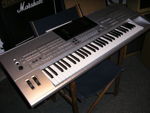 |
[?] This is, at a guess, the Yamaha referred to in the sleeve notes of the album.
|
| Yamaha Vocaloid |
Virtual vocalist software, capable of 'singing' using sets of voice samples. |
|
| Return To Ommadawn (2017) |
| Clavioline |
Clavioline software emulation used on Return To Ommadawn. |
|
| Solina string ensemble |
String synthesiser produced by the Dutch organ company Eminent and later rebadged by ARP. It owed much of its sound to its ensemble effect, created by running the sound through three LFO-modulated delay lines. |
Mike used a software emulation of a Solina rather than the real thing on this album.
|
| Farfisa Professional Organ |
Return To Ommadawn used a Farfisa sotware emulation.

 |
|
| 1970 Hammond L.122 Organ |
Return To Ommadawn used an Hammond software simulation. |
|
| Vox Continental Organ |
Return To Ommadawn used a Vox software emulation. |
|

